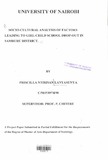| dc.description.abstract | The main thrust of this project was to examine the factors that perpetuate the gender
disparity in education in Samburu District, specifically Girl-child school drop out.
This was mainly brought about by the fact that many girls enroll in primary school, in
standard one (1), but their number continues to decrease as years go by. Only a handful of
them manage to complete primary education compared to boys.
Just as Dr. Edward Clarke (Clarke 1873 :54 cited in Rosenberge 1982: 18) said that" A
girl whom nature for a limited period and for a definite purpose, imposes so great
physiological task, will not have much power left for the tasks of school as the boy"
Women though not entirely, excluded from education generally and higher education for
that matter, their percentage continues to decline as one move up the educational
hierarchy.
This study therefore was set up to investigate whether, social factors such as early
pregnancy, attitude of the parents, Economic status of the parent and Cultural factors
such as early marriages, mobility due to insecurity as a result of cattle rustling contribute
to the girl child school drop out in Samburu District.
The literature review, a brief overview of the Samburu community is given focusing on
the status of women education, mobility, their economy and the girl child. Also literature
on specific factors that contribute to the school drop out of girls was also reviewed some
of which are early marriages, community attitude towards girl-child education, distance
to school, domestic chores, family economic status and nomadic pastoralism in relation to
girl child school drop out.
The site for the research was Samburu District which is Rift Valley. The area is mostly
arid and semi-arid inhabited by the nomadic pastoralists. The methodology used to collect data was snowball due to the fact that one has to inquire
about those girls who dropped out of school and it is them who can identify others who
also left school like them.
The findings indicated that early pregnancy was the major factor which causes girls to
drop out. This also has an implication that many parents for fear that their daughters will
get pregnant before completing school they will not hesitate for them to get married
early. | en |

